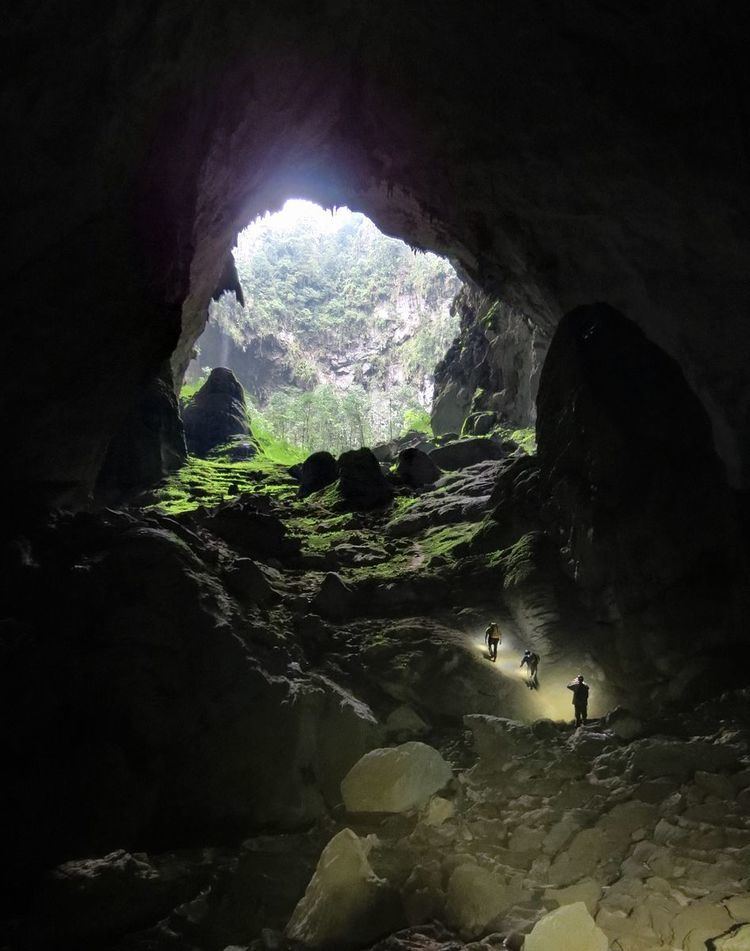Depth Max 150m / 490ft Hazards Underground river Discovery 1991 | Entrances Approx 2 Province Quang Binh Province Parent range Annamite Range | |
 | ||
Length Approx 9,000 m / 30,000 ft Address Thượng Trạch, Bố Trạch District, Quang Binh Province, Vietnam Similar Phong Nha‑Kẻ Bàng Nati, Phong Nha Cave, Mount Roraima, Ha Long Bay, Lake Hillier | ||
Hang Sơn Đoòng (Vietnamese: Việt Nam ([haːŋ˧ ʂəːn˧ ɗɔ̤ŋ˨˩]); 'cave of the mountain river' or 'mountain cave of Đoòng [village]' in Vietnamese), also known as Sơn Đoòng cave (often without the tone marks) is a solutional cave in Phong Nha-Kẻ Bàng National Park, Bố Trạch District, Quảng Bình Province, Vietnam. As of 2009 it has the largest known cave passage cross-section in the world, and is located near the Laos–Vietnam border. Inside is a large, fast-flowing subterranean river. It was formed in Carboniferous/Permian limestone.
Contents
Discovery
Hang Sơn Đoòng was found by a local man named Hồ Khanh in 1991. The whistling sound of wind and roar of a rushing stream in the cave heard through the entrance as well as the steep descent prevented the local people from entering the cave. Only in 2009 did the cave become internationally known after a group of cavers from the British Cave Research Association conducted a survey in Phong Nha-Kẻ Bàng from 10 to 14 April 2009. Their progress was stopped by a large, 60-metre (200 ft) high calcite wall, which was named the Great Wall of Vietnam. It was traversed in 2010 when the group reached the end of the cave passage.
Description
According to the Limberts, the main Sơn Đoòng cave passage is the largest known cave passage in the world by volume – 38.4×106 cubic metres (1.36×109 cu ft). It is more than 5 kilometres (3.1 mi) long, 200 metres (660 ft) high and 150 metres (490 ft) wide. Its cross-section is believed to be twice that of the next largest passage, in Deer Cave, Malaysia. The cave runs for approximately 9 kilometres (5.6 mi) and is punctuated by 2 large dolines, which are areas where the ceiling of the cave has collapsed. The dolines allow sunlight to enter sections of the cave which has resulted in the growth of trees as well as other vegetation.
The cave contains some of the tallest known stalagmites in the world, which are up to 70 m tall. Behind the Great Wall of Vietnam were found cave pearls the size of baseballs, an abnormally large size.
Tourist activities
In early August 2013, the first tourist group explored the cave on a guided tour at a cost of US$3,000 each. Permits are required to access the cave and are made available on a limited basis, with 800 permits available for the 2017 season, which runs from February to August. After August, heavy rains cause river levels to rise and make the cave largely inaccessible.
Development plans
Plans are being considered to build a cable car through the cave. The proposed system would be 10.5 kilometres (6.5 mi) long, and cost between $112 and $211 million. The plans are opposed by environmentalists.
